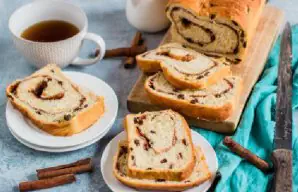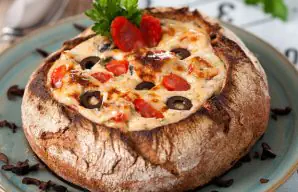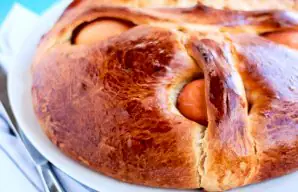Posted on Sunday, April 24, 2016 in
Bread Recipes
Deliciously Airy Crusty Buns Recipe
These deliciously airy crusty buns (papo secos crocantes), are crusty on the outside and light in the inside, perfect for sandwiches or with anything.
| Preparation time | 1 h 45 min |
| Cooking Time | 30 min |
| Ready In | 2 h 15 min |
| Level of Difficulty | Easy |
| Servings | 10 |
Nutrition Facts (Per Serving)
| Calories | 168 |
| Fat | 0.5g |
| Carbs | 35g |
| Protein | 5g |
Ingredients
4 cups of all purpose flour2 teaspoons of salt1 teaspoon of sugar2 and 1/2 teaspoons of active dry yeast1 and 1/2 cups of lukewarm water1/2 cup of lukewarm water1 egg white beaten or milk for brushing
Get Portuguese ingredients 
Preparation
Makes about 10 buns.
- In a small bowl, add the 1/2 cup of the warm water, add the yeast, the teaspoon of sugar, stir and let it proof (foam up).
- Using a large bowl mix together the flour and salt.
- Add the yeast mix into the flour plus the 1 and 1/2 cups of the warm water.
- At this time you will need to use your hands to combine everything well together.
- Take the dough out into a floured surface and knead for a couple of minutes.
- Place the dough into a greased bowl and cover with a dish towel or blanket.
- Place the bowl in a warm place and let the dough rise for an hour.
- Remove the dough and place onto a floured surface, punch the dough down, and knead for about 10 minutes, until the dough feels smooth.
- Separate the dough into ten equal balls.
- Shape them and place them on a greased or parchment paper lined baking trays, and let them rise for 30 minutes.
- You can shape the rolls by making an indent in the middle with the side of your hand, or you can roll the dough into an oval shape and score with a knife across the top lengthwise before it goes in the oven.
- Preheat the oven at at 190°C or 375°F and brush the rolls with either egg white or milk.
- Bake for 30 minutes or until the rolls are slightly golden brown and sound hollow when tapped on the bottom.
Recipe adapted from a recipe by: azoreangreenbean.com
Photo Credit: Unknown
Recommended Recipes
Lydia's Yum Cinnamon and Raisin Bread Recipe
Lydia's yum cinnamon and raisin bread, has a great consistency and smells wonderful, it's great with coffee or tea.
| Level of Difficulty | Easy |
| Servings | 10 |
Bread with Linguiça and Cheese Recipe
This bread with linguiça and cheese recipe (receita de pão gratinado com linguiça e queijo), is easy to make and delicious.
| Level of Difficulty | Very Easy |
| Servings | 8 |
Traditional Easter Sweet Bread Recipe
This traditional Easter sweet bread (folares de pascoa), is delicious and very popular during Easter.
| Level of Difficulty | Easy |
| Servings | 8 |
Comments



Grace Macedo
My son is looking for a Portuguese recipe for a pastry with custard. He had the dessert in the Azores and wanted me to see if I had it in my Portuguese cook books. I cannot find one except for Portuguese Milk Tarts (Queijadas de Leite).
Thank you
Grace
1 Year ago, Tuesday, January 16, 2024




